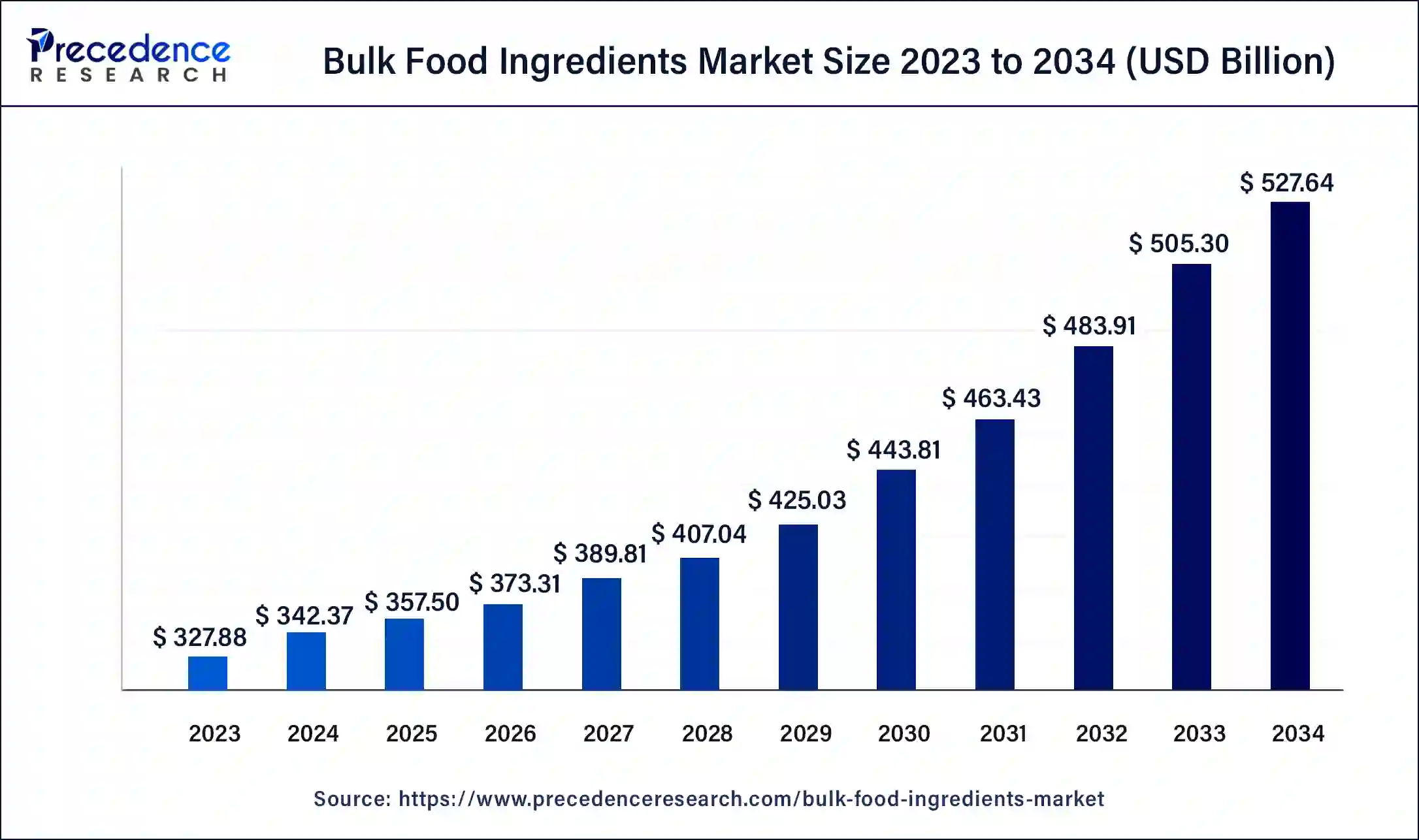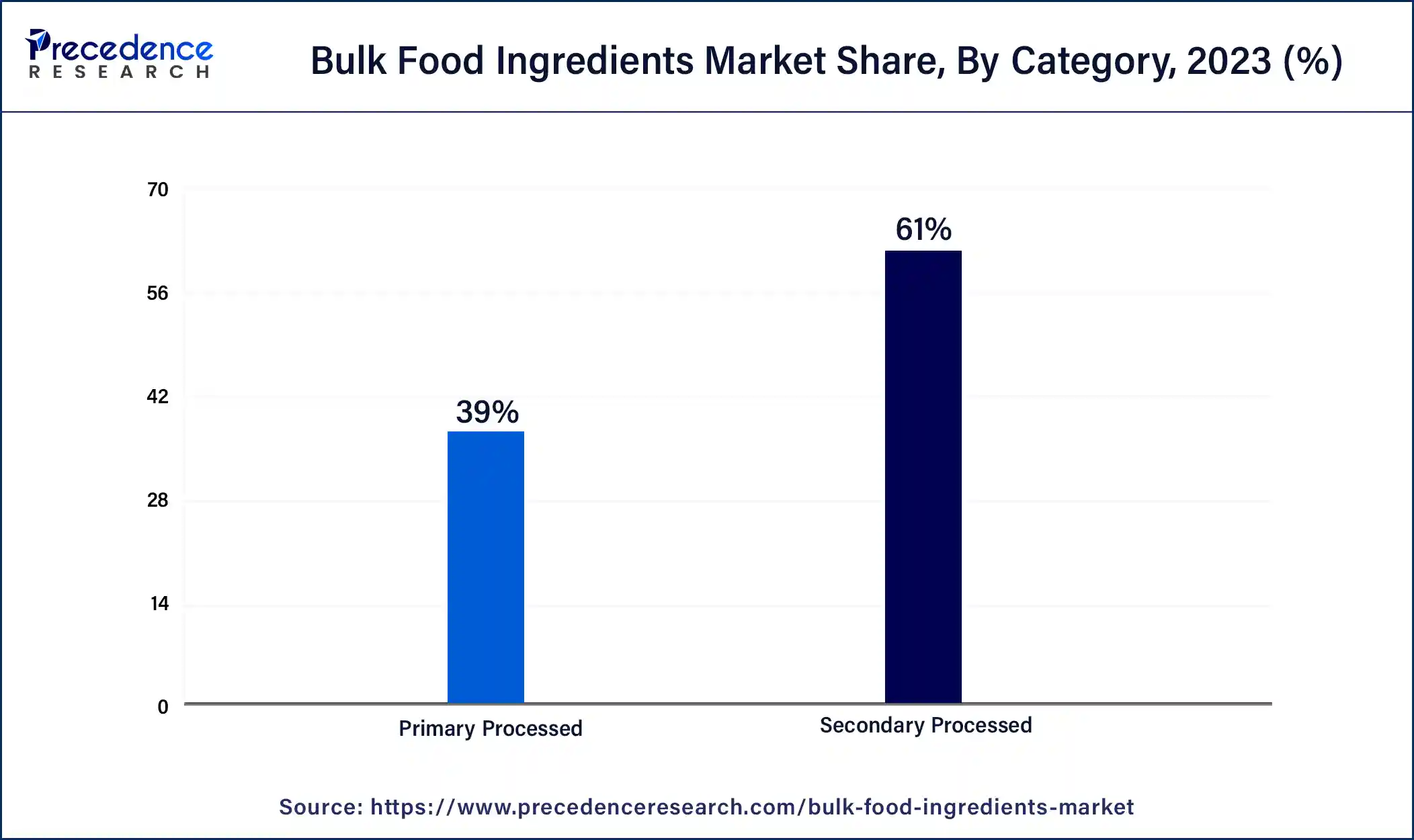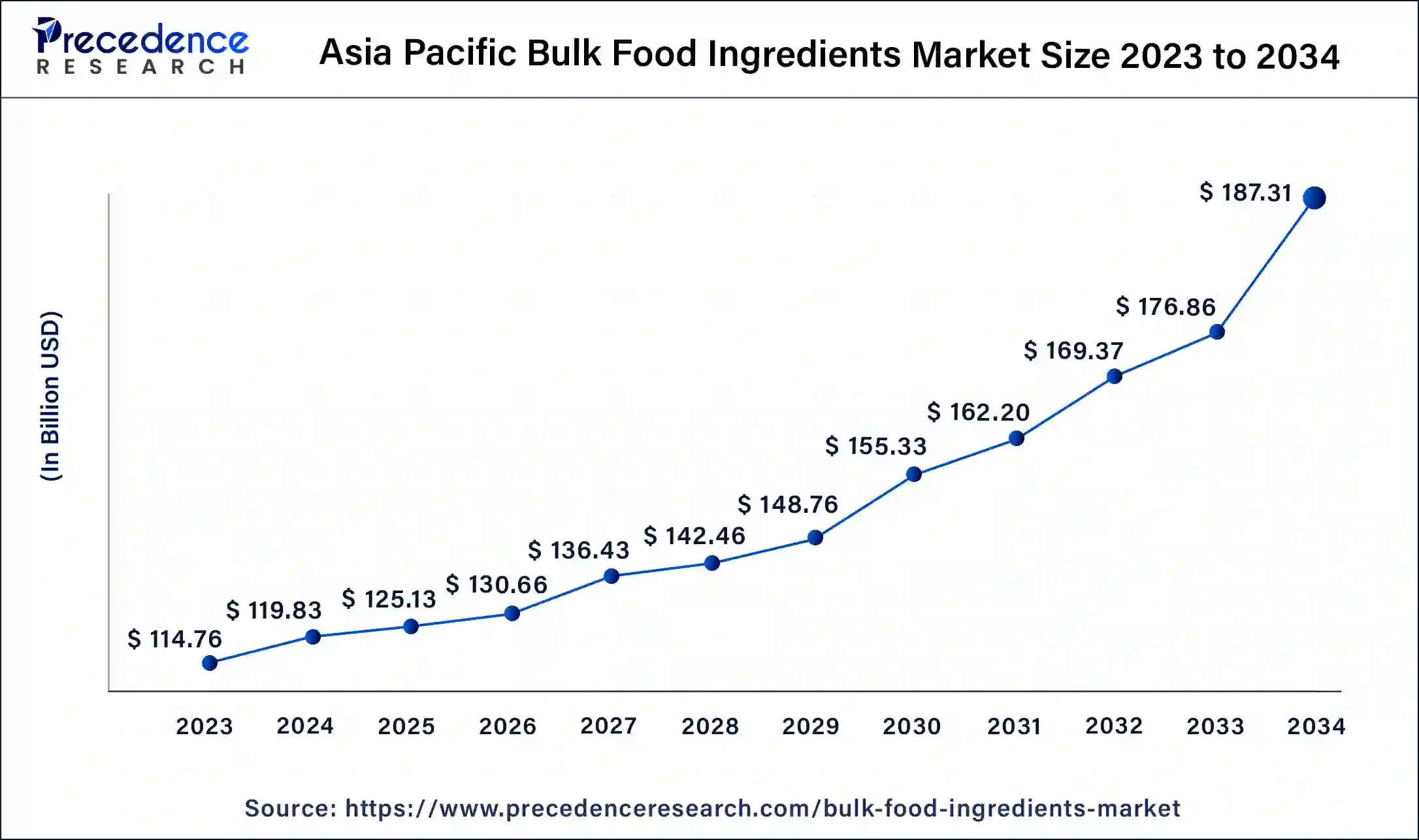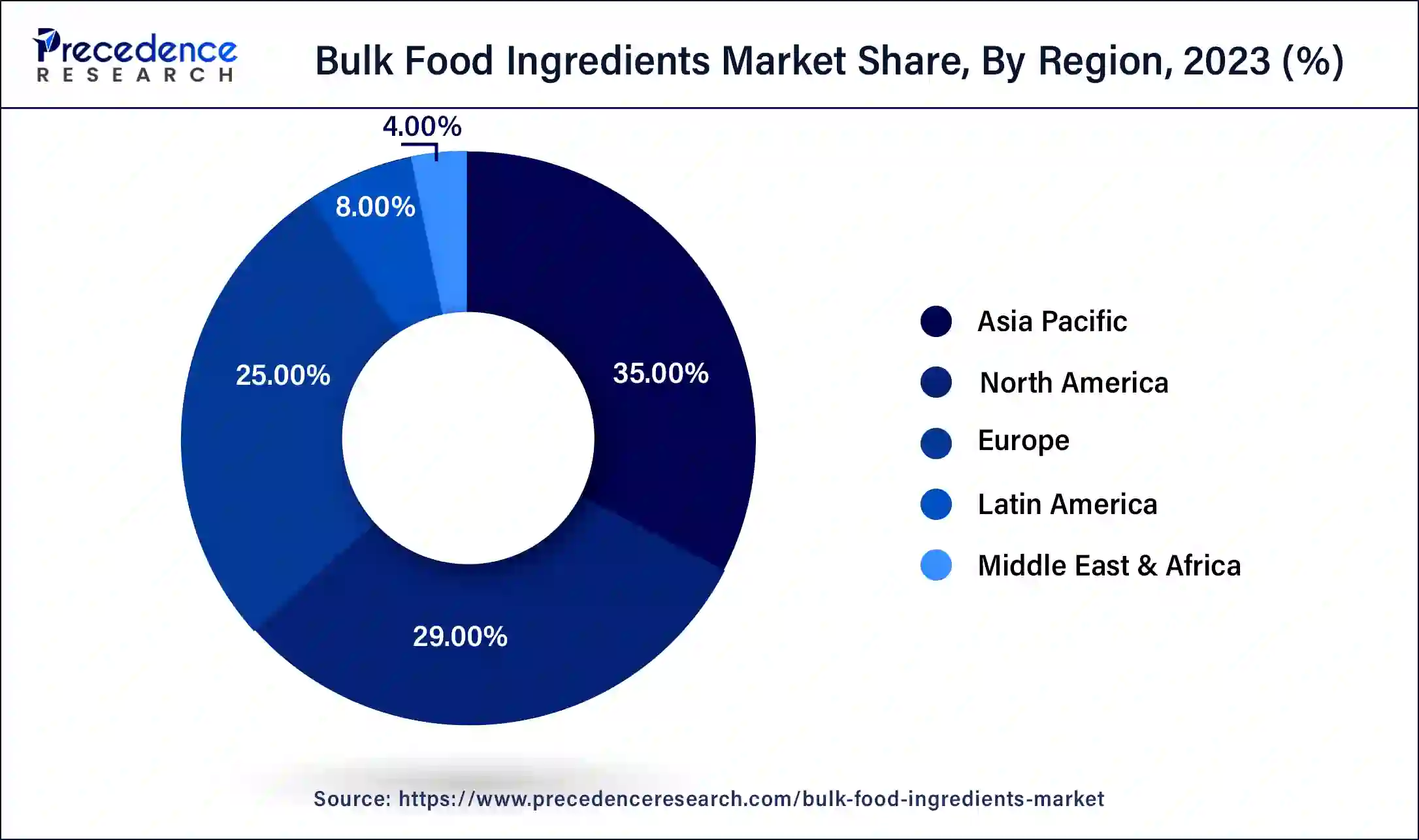List of Contents
What is the Bulk Food Ingredients Market Size?
The global bulk food ingredients market size is valued at USD 357.50 billion in 2025 and is predicted to increase from USD 373.31 billion in 2026 to approximately USD 527.64 billion by 2034, expanding at a solid CAGR of 4.42% over the forecast period 2025 to 2034. The bulk food ingredients market growth is attributed to the growing demand for cost efficiency, reduced packaging waste, easy inventory control, and operational effectiveness, which is beneficial in the long run to survive constant industry changes.

Bulk Food Ingredients Market Key Takeaways
- In terms of revenue, the bulk food ingredients market is valued at $357.5 billion in 2025.
- It is projected to reach $527.64 billion by 2034.
- The bulk food ingredients market is expected to grow at a CAGR of 4.42% from 2025 to 2034.
- Asia Pacific dominated the bulk food ingredients market with the largest market share of 35% in 2024.
- By category, the secondary segment contributed the highest market share of 61% in 2024.
- By category, the primary segment is expected to grow at a notable CAGR of 4.02% during the forecast period.
- By application, the bakery & confectionery segment generated the biggest market share of 32% in 2024.
- By application, the beverage segment is anticipated to grow at solid CGAR of 5.03% during the forecast period.
Market Overview
Bulk food ingredients consist of components used in packaged, processed, and ready-to-eat food purchased in large quantities. A wide range of food ingredients are distributed globally, from farm-grown raw food, processed and semi-processed to ultra-processed food. The bulk food ingredients market is in high demand by distributors, wholesalers, restaurants, consumers, and retailers.
Food such as dried beans and lentils, frozen fruits and meat, nuts in shells, whole grains, honey, oats, dried pasta, and oils are bought and stored in large quantities. The dehydrated and unprocessed food items have an extended shelf life, maintaining quality even when stored at room temperature, lasting from 3-5 years to 10 years when stored under suitable conditions. Hence, there is no unnecessary wastage of food.
- It is estimated that the world wastes about 2.5 billion tons of food every year. The United States discards more food than any other country in the world, nearly 60 million tons to 120 billion pounds every year.
Bulk Food Ingredients Market Growth Factors
- With the adoption of sustainability in awareness of environmental impact, consumers and businesses are demanding responsibly sourced and produced ingredients, which is driving the market growth.
- The bulk food ingredients market is witnessing a surge in demand for clean labels for transparency in labeling and encouraging manufacturers to produce simpler and natural ingredients.
- As the entire food industry is adapting to plant-based transformation. With the increasing popularity of plant-based diets. Plant-based protein, flour alternatives, and non-dairy alternatives are also in demand. Thus driving the bulk food ingredients market.
- Increasing awareness for nutrition and nutraceuticals food such as fortified cereals, and protein-rich food is growing the demand for bulk food ingredients.
- Innovation in advanced processing technology, including advanced milling techniques and precision extraction methods that improve the quality and efficiency of ingredient production, is driving the bulk food ingredients market.
- Increasing demand for spices, herbs, and other distinctive ingredients is increasing the globalization of flavors, which encourages suppliers to expand the sourcing network, contributing to the growth of bulk food ingredients.
- With the help of e-commerce distribution of source production at the online marketplace, the demand for bulk food ingredients is increasing.
Bulk food ingredients market outlook
- Industry Growth Overview: Between 2025 and 2030, this market is expected to rise significantly due to the growing demand for dry fruits in developed nations coupled with rapid expansion of the food and beverage sector.
- Major Investors: Numerous aerogel companies are actively entering this market, drawn by collaborations, R&D and business expansions. Numerous market players such as Cabot Corporation, Dow, Inc., Aspen Aerogels, Inc., and some others have started investing rapidly for developing high-quality aerogel for end-user industries.
- Startup Ecosystem: Various startup companies are engaged in developing aerogels for end-user industries. The prominent startup brands dealing in manufacturing aerogel solution comprises of Blueshift Materials, OROS, Graphene Composites and some others.
Market Scope
| Report Coverage | Details |
| Market Size by 2034 | USD 527.64 Billion |
| Market Size in 2025 | USD 357.50 Billion |
| Market Size in 2026 | USD 373.31 Billion |
| Market Growth Rate from 2025 to 2034 | CAGR of 4.42% |
| Largest Market | North America |
| Base Year | 2024 |
| Forecast Period | 2025 to 2034 |
| Segments Covered | Category, Application, and Regions |
| Regions Covered | North America, Europe, Asia-Pacific, Latin America and the Middle East & Africa |
Market Dynamics
Drivers
Sustainable packaging
Purchasing food in bulk saves time, cost, and packaging material. The practice of buying food in large quantities is efficient and sustainable for the environment. This awareness-conscious practice drives the growth of the bulk food ingredients market. The primary advantage of bulk packaging is the ability to reduce cost and minimize environmental impact. Packaging waste is reduced by businesses packing the food in large quantities. This contributes to promoting an eco-friendly planet and also saves substantial costs for companies.
- In September 2024, California passed its second ban on plastic grocery bags. The first ban was passed in 2014 when 157,385 tons of plastic bag waste were discarded in California. By 2022, the tonnage of discarded plastic bags had skyrocketed to 231,072 — a 47% jump. After the increase in population, the number rose from 4.08 tons per 1,000 people in 2014 to 5.89 tons per 1,000 people in 2022.
Transportation of goods has made a significant impact on the environment by increasing its carbon footprint. The shipment of large quantities is achieved in a single container and one-way travel. This cuts down on fuel consumption and decreases emissions associated with transportation. This responsible practice performed by the bulk food ingredients market creates a positive impact on the environment. Bulk packaging bags can transport and store larger quantities of products, optimizing logistics, reducing storage costs, and enhancing overall operational efficiency for business operations.
- As per the International Energy Agency (IEA), road transport is a major contributor to global greenhouse gas emissions. On average, a typical passenger car emits about 4.6 metric tons of CO2 every year.
- According to the Ministry of Housing and Urban Affairs (MoHUA), the adoption of public transit contributes to significantly reducing greenhouse gas emissions; a fully-occupied bus emits much less CO2 per passenger than a passenger traveling in private.
Restraint
Inadequate storage
Improper storage of bulk food leads to food spoilage through decay, bacteria and mold growth, and wastage of food. The consumption of spoiled or contaminated food causes foodborne illness. Food services, industries, and households need to have an equipped storage area and procedures to be able to purchase supplies in large quantities; the ability to store supplies on the premises reduces the cost and time when needed; menu planning is easier when aware of the available ingredients that are on hand.
In present days, many food service industries are reducing the amount of stocks on hand because storage is expensive. Many operators pay extra amounts for supplies to avoid the stress of keeping track of expensive items such as large quantities of high-quality meat, wine, and spirits. However, some necessary items such as dry foods, dairy products, frozen foods, produce, and fresh meats are stored in the industry. The storage area for these items has a required design for efficient handling.
Opportunity
Different ways of food production
In the coming future, an innovative style of food is expected to be produced. With the rising world population, global warming, unavailability of food, and changing perspectives on sustainability, food will undergo major changes. Considering all the factors, mankind is anticipated to shift to alternate crops that are grown with less carbon footprint, sufficient quantity, and high nutritional value. Options such as lab-grown meat, edible insects, seaweed, and plant-based food are expected to bring about new changes in food production and the agriculture industry.
- By 2050, the global population is expected to rise to 10 billion people, which means it will take 56% more food than produced in the world today to feed everyone.
Category Insights
The secondary segment held the largest share of the bulk food ingredients market in 2024. The rising demand for ready-made meals, breakfast cereals, cured meats, chicken nuggets, and pet foods is boosting the growth of the bulk food ingredients market. Secondary processed food involves converting raw food into more processed and edible form. These are more refined, purified, transformed, or extracted from primarily processed food. Examples of secondary food products are processed dairy, flours, edible oils, sugars/sweeteners, and starches. They vary depending on the type of food group but include physical processes such as pressing, milling, and dehydration and chemical processes such as hydrolysis, hydrogenation, or using enzymes. North America and Europe are the biggest consumers of secondary processed food. In Europe, the United Kingdom, France, and Germany hold half the sales of ready-to-eat food. Asian countries currently consume very few ready meals; on average, consumption amounts to only 3.5 kg per year and per person. This is nearly half the amount that Americans eat.

The primary segment is expected to grow at the fastest rate in the bulk food ingredients market during the forecast period. Increasing demand for more palatable and digestible food is projected to grow the primary processed food segment. Primary processing turns agricultural feed into edible food such as wheat or corn kernels, which are further processed into flour or maize. Some examples of it are vegetables, fruits, legumes/beans/pulses, cereals, tubers, meat, milk, poultry, egg, fish and other seafood. Canning fruits and vegetables, deboning and cutting meat, candling eggs, and pasteurizing milk are also processes that fall in the initial stages of food processing. India is the largest agricultural production country in the world for milk, jute, and pulses. China is the world's largest producer of rice, wheat, corn, and potatoes.
Application Insights
The bakery & confectionery segment dominated the bulk food ingredients market in 2024. This dynamic industry is driven by urbanization, rising disposable income, and a growing preference for convenience food, which offers a wide range of products that cater to consumers' tastes. This segment continues to grow and evolve in terms of breads, biscuits, and confectionery chocolates. Under bread, a variety of products are produced, such as white bread, wholewheat bread, rye bread, and many more, with specialized bread dough such as sourdough, cornbread, and yeast. Under biscuits, a variety of tastes and textures for a wide range of occasions and appetites, such as rolled biscuits, drop biscuits, scones, and shortcakes. Asia is the largest producer of bakeries, and Europe is second.
The beverage segment is anticipated to grow rapidly in the bulk food ingredients market in the coming years. With the increasing population, demand for no-alcohol and low-alcohol beer, wine, seltzers, and more is growing. The market is expected to rise steadily with growing urbanization in nations like India and China. The demand for convenient, on-the-go beverages has surged, leading to advancements in recipes and packaging.
Regional Insights
Asia Pacific Bulk Food Ingredients Market Size and Growth 2025 to 2034
The Asia Pacific bulk food ingredients market size is exhibited at USD 125.13 billion in 2025 and is projected to be worth around USD 187.31 billion by 2034, poised to grow at a CAGR of 4.57% from 2025 to 2034.

Asia Pacific held the largest share of the bulk food ingredients market in 2024. The demand for food products due to health awareness is growing due to consumers' concerns about heart disease, obesity, and high cholesterol. The high consumption of food products such as meat, bakery & cereals, dairy & soy food, fish & seafood, oils, fats, and others are witnessed in the region, which contributes to the growth of the market.
The bulk food ingredients market in India is undergoing a renaissance fueled by urbanization, increasing incomes, and changing diets. The momentum has also benefited from government interventions by the Pradhan Mantri Kisan SAMPADA Yojana (PMKSY) and the Production Linked Incentive Scheme for Food Processing Industry (PLISFPI) related to infrastructure and supply chain enhancements. India's diversity of agro-climatic conditions and favourable factors that facilitate the production of milk, spices, fruits, and vegetables ensure that the growing demand for bulk food ingredients can be met.

North America is observed to witness the fastest rate of expansion throughout the forecast period in the bulk food ingredients market. The U.S. and Canada have the largest food and beverage companies, such as PepsiCo., Tyson Foods, JBS USA, Nestle, and Kraft Heinz. The beverage industry in the United States is experiencing growth due to the increasing demand for nutrition-focused products such as shakes, bars, powder, and others. Additionally, there is a growing awareness of healthy drinks, which has led to a rise in consumption of both alcoholic and non-alcoholic beverages. The U.S. is home to 37,000 food and beverage processing plants.
The U.S. bulk food ingredients market is growing, as consumers are now demanding more convenience foods, clean-label products, and plant-based foods. The increasing popularity of ready-to-eat meals and snacks is also driving demand for bulk ingredient staples such as grains, spices, and sweeteners. Companies are investing in facility upgrades to meet growing demand, as Kraft Heinz announced a $3 billion investment plan to upgrade its 30 manufacturing plants in the U.S. and improve operational efficiencies throughout the company, while continuing food production despite economic uncertainties and tariffs imposed by the U.S. government. Together, these developments demonstrate the growth potential of the U.S. bulk food ingredients market with changing consumer preferences and significant investments by key industry players.
Value-Chain Analysis
- Storage and Cold Chain Logistics
Food ingredients are stored based on their requirements (dry, refrigerated, or frozen) and managed through a specialized food logistics system that emphasizes temperature control, hygiene, and efficient inventory management to ensure safety and preserve freshness.
Key Companies: Americold Logistics, Murphy Logistics, DahNay Logistics and some others.
- Processing and Packaging
Food ingredients are processed through methods like washing, sorting, heating, and preserving, and then packaged in containers such as cans, bottles, and bags to extend shelf life and for transport. Packaging methods like using cans, flexible containers, or boxes protect the food from contamination and physical damage.
Key Companies: EPL Limited, TCPL Packaging, Sri Gayathri Packaging Industries and some others.
- Distribution Channel
Food ingredient distribution channels are networks that move ingredients from producers to consumers, primarily through indirect channels that use intermediaries like processors, wholesalers, and distributors to get products to retailers and foodservice operators.
Key Companies: DMH Ingredients, Inc., McCormick & Company, Inc, GCL Food Ingredients, and some others.
Key Players: Delivering food ingredients globally
- Cargill, Incorporated: Cargill, Incorporated is an American multinational corporation involved in the food, agricultural, financial, and industrial sectors. It provides food ingredients, agricultural solutions, and industrial products by connecting farmers with markets and customers with ingredients through a global supply chain.
- Archer-Daniels-Midland Company: ADM, or Archer Daniels Midland, is a multinational corporation headquartered in Chicago, Illinois, that processes agricultural commodities into food, animal feed, and other products. Its business includes global origination and processing of crops, as well as the manufacturing and distribution of products such as sweeteners, oils, and flavors.
- Bunge Limited: Bunge Limited is a global agribusiness and food company involved in the entire farm-to-consumer food chain, operating through segments like agribusiness, refined and specialty oils, milling, and sugar and bioenergy. It processes and trades grains, oilseeds, and other agricultural products, and produces edible oils, flour, and animal feed.
- Associated British Foods plc: Associated British Foods plc (ABF) is a diversified multinational food, ingredients, and retail company based in London, UK. This company aims to provide affordable food and clothing by operating globally across Europe, Africa, the Americas, and Asia-Pacific.
- Olam International: Olam International is a leading food and agri-business that operates a global supply chain from "seed to shelf," involved in sourcing, processing, and distributing a wide range of agricultural products and food ingredients. This company is headquartered in Singapore and holds a leading position in commodities including cocoa, coffee, and spices and is a major supplier of food, feed, and fiber to numerous customers worldwide
- Tate & Lyle: Tate & Lyle is a British-headquartered global supplier of specialty food and beverage ingredients. The company provides solutions including sweeteners, textures, and fibers to help customers reduce sugar, calories, and fat, and added fibers and protein to the end-users.
Bulk Food Ingredients Market Companies
- DUPONT DE NEMOURS, INC
- Essex Food Ingredients
- Ingredients Inc.
- Corbion
- Koninklijke DSM N.V
- EHL Ingredients
- McCormick & Company, Inc
- GCL Food Ingredients
- Dmh Ingredients, Inc.
Recent Developments
- In March 2025, Hain Celestial's Earth's Best, the organic baby brand, launched a new line of organic "play and learn" finger foods designed specifically to help little ones practice and develop their motor skills. "At Earth's Best, our mission is to help little ones build healthy habits, and the transition to solid foods is a perfect time and place to start," says Emily Rosen, senior director of marketing at Earth's Best. (Source: https://www.snackandbakery.com)
- In April 2025, Nestlé and Olam Food Ingredients (OFI) announced their largest joint agroforestry initiative to date, a partnership aimed at transforming cocoa farming and tackling the dual threats of carbon emissions and deforestation. (Source: https://www.foodbev.com)
- In August 2024, Pilmico Foods and Gold Coin merged to form Aboitiz Foods. The new company's 29 facilities are located in the Philippines, China, Vietnam, Malaysia, Indonesia, Singapore, Thailand, and Brunei. Tristan R. Aboitiz, president and CEO of Aboitiz Foods, stated, “We recognize the evolving needs of the region's food landscape and, with a renewed focus on innovation, we're determined to unlock new opportunities across the entire food value chain.” (Source: https://www.feedstrategy.com)
- In May 2022, Cargill invested USD 5.75 million in Cubiq Foods Receives Investment for cultivated fat-based ingredients, Spanish start-up Cubiq Foods, to scale up its cultivated fat-based ingredient for plant-based meat alternatives.
- In June 2024, CP Kelco and Tate & Lyle are set to merge, creating a global powerhouse in food and beverage product development and customer service solutions. Tate & Lyle has been a world leader in ingredient solutions for healthier food and beverages for over 160 years.
- In November 2025, Olga launched egg and gelatin alternatives. These alternatives are designed for the consumers of Europe.
(Source: https://vegconomist.com) - In September 2025, FrieslandCampina Ingredients announced to open a new application center in Singapore. This center is opened to accelerate the development of functional food in the APAC region.
(Source: https://www.foodingredientsfirst.com) - In June 2025, Compound Foods launched beanless coffee and cocoa ingredient platform. This platform is designed for the food and beverage companies of the U.S.
(Source: https://www.foodbusinessnews.net )
Segments Covered in this Report
By Category
- Primary Processed
- Grains, Pulses & Cereals
- Tea, Coffee & Cocoa
- Herbs And Spices
- Oilseeds
- Sugar & Salt
- Others
- Secondary Processed
- Processes Grains, Pulses & Cereals
- Processes Herbs & Spices
- Dry Fruits & Nuts
- Sugar & Sweetener
- Other
By Application
- Bakery & Confectionery
- Snacks & Spreads
- Ready Meals
- Beverages
- Others
By Region
- North America
- Asia Pacific
- Europe
- Latin America
- Middle East & Africa
For inquiries regarding discounts, bulk purchases, or customization requests, please contact us at sales@precedenceresearch.com
Frequently Asked Questions
Ask For Sample
No cookie-cutter, only authentic analysis – take the 1st step to become a Precedence Research client